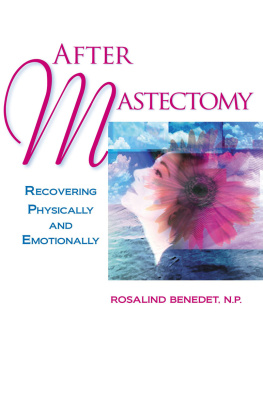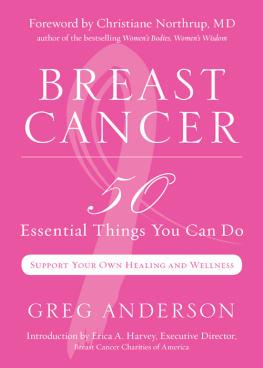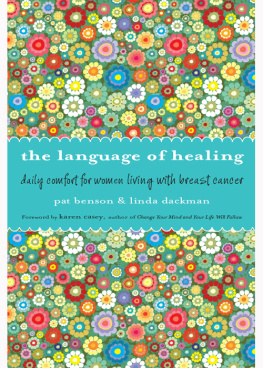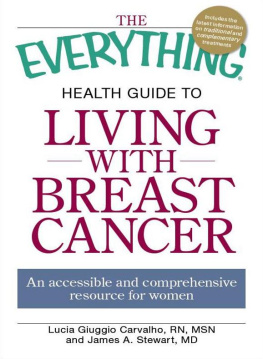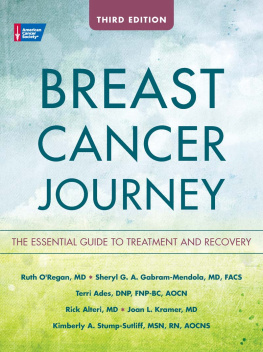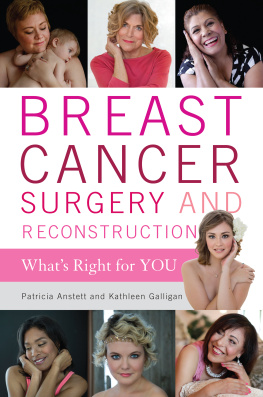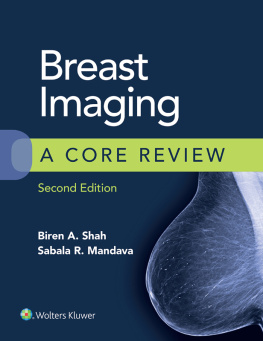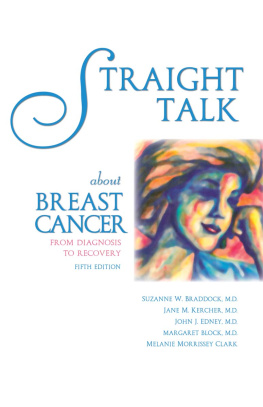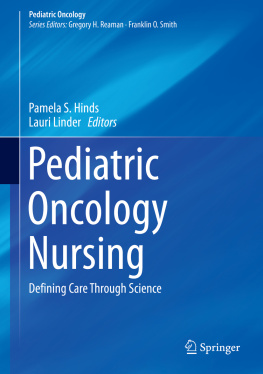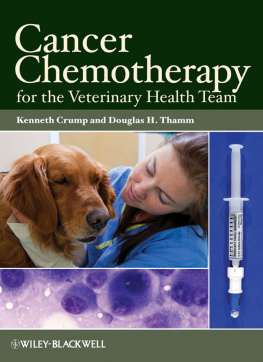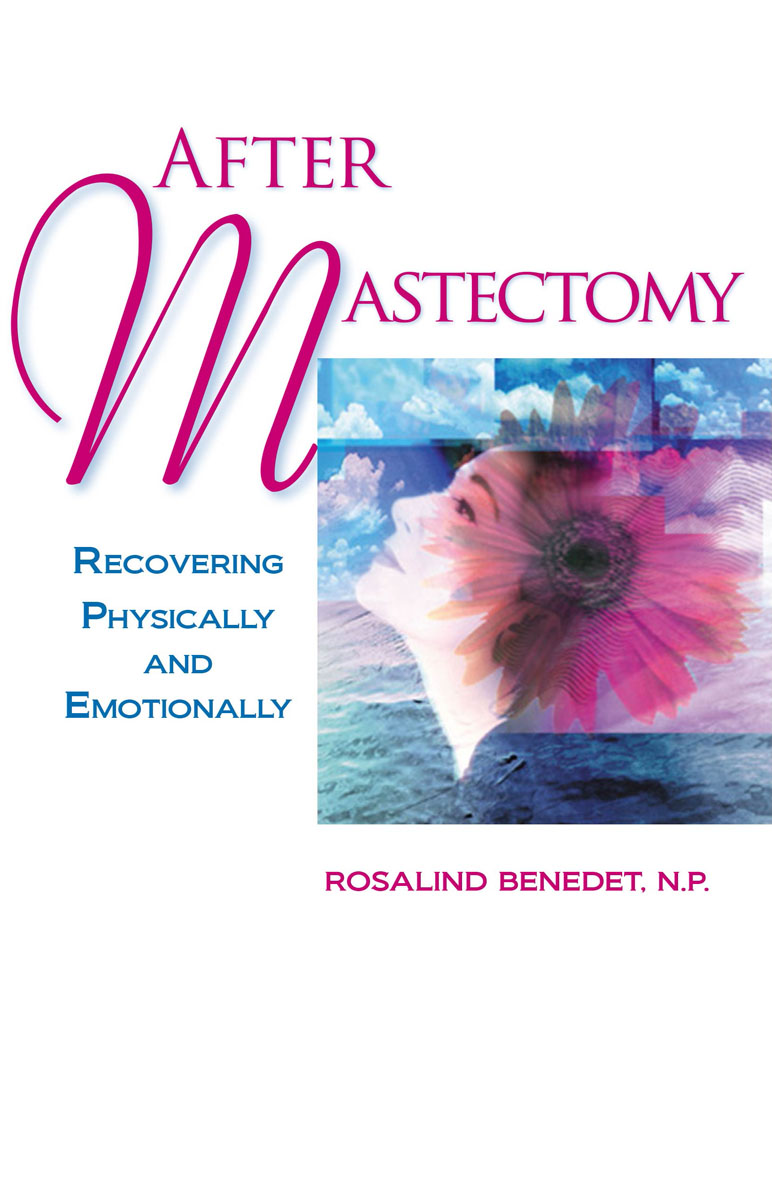
An Addicus Nonfiction Book
Copyright 2019 by Rosalind Benedet. All rights reserved. No part of this publication may be reproduced, stored in a retrieval system, or transmitted in any form or by any means, electronic, mechanical, photocopied, recorded, or otherwise, without the prior written permission of the publisher. For information, write Addicus Books, Inc., P.O. Box 45327, Omaha, Nebraska 68145.
ISBN: 978-1-886039-61-2
Cover design by Peri Poloni-Gabriel
Typography and illustrations by Bob Hogenmiller and Jack Kusler
This book is not intended to be a substitute for a physician, nor do the authors intend to give advice contrary to that of an attending physician.
Library of Congress Cataloging-in-Publication Data
Benedet, Rosalind Dolores.
After mastectomy : healing physically and emotionally/Rosalind Benedet.
p. ; cm.
Includes index.
ISBN 1-886039-61-5 (alk. paper)
1. MastectomyPopular works.
[DNLM: 1. MastectomyrehabilitationPopular Works. 2. Breast NeoplasmstherapyPopular Works. WP 910 B462a 2003] I. Title. RD667.5.B46 2003
618.19059dc21 2003002584
Addicus Books, Inc.
P.O. Box 45327
Omaha, Nebraska 68145
AddicusBooks.com
Printed in the United States of America
10 9 8 7 6 5 4 3 2
In the middle of difficulty lies opportunity.
Albert Einstein
C ONTENTS
A CKNOWLEDGMENTS
I would like to thank my patients for helping make this book possible. Were it not for what they have taught me, I could not have written this book. Their strength and resilience have inspired me. Their wisdom has enriched my life.
I NTRODUCTION
I am an oncology nurse. For the last twenty years, I have worked exclusively with women who have been diagnosed with breast cancer.
My focus has been to help women through their breast cancer journey, from the time of diagnoses, throughout treatment, and after treatment ends.
Over the years I have learned many things along the way. My patients have been my best teachers. They have shown me that physical and emotional recovery is a process that requires time, effort, information, and open communication. My patients have also taught me that the diagnosis of cancer can be used as a powerful motivator for a healthier life physically and emotionally.
It is my hope that, through this book, I may pass on some of the many lessons these women have taught me. Lessons to help you in both your physical and emotional recovery.
1
R ECOVERING AFTER S URGERY
E ven though a mastectomy is major surgery, most women are surprised that they feel much better than they expected they would by the time they return home. Still, youll need to take it easy for awhile. You may have the help of friends and relatives, but youll probably find that most of your personal care will be up to you. This chapter is to help you during the first few days that youre home.
Energy and Bed Rest
Although you probably wont have a great deal of post-surgical discomfort by the time you arrive home, you will probably feel fatigued both from the surgery and from the medications you received. Plan to get extra rest. Take short nap during the day and try to get extra sleep at night. But bed rest is not encouraged, because inactivity leads to more fatigue.
How much can you do and how soon? Follow the guidelines from your doctor but a good rule of thumb is to do what you feel capable of doing.
Generally, you can resume your normal, daily activities such as grooming, bathing, dressing, and eating, without assistance. However, for more strenuous household tasks, you will need the help of family and friends. Avoid any heavy lifting, pushing, or pulling for six weeks. But you may do light household activities such as washing a few dishes, making a simple meal, and setting the table. Be gentle in using your affected arm. Theres a natural tendency to favor the side where the operation was done and to hold your arm stiffly at your side. Try to keep your affected arm, neck, and shoulder relaxed.
Managing Pain
You will be more likely to experience some post-surgical pain if your operation involved the removal of lymph nodes. If you do feel some discomfort, there are a number of steps you can take to ease the pain.
Prescription Pain Medication
Your doctor will give you a prescription for a pain medication, be sure to have the prescription filled right away. If you feel pain, take the prescribed dose as recommended. Some women resist taking these medications because they worry about dependency. But in all likelihood, you wont need to take a prescription painkiller for more than a few days and nights, so dependency is not really an issue.
If you have pain, take your pain medication on a regular schedule before pain intensifies. If you wait until the pain starts, youll have to endure the discomfort while you are waiting for the medication to work. And you will probably take more medication in the long run.
Over-the-Counter Medications
Side effects of prescription drugs, especially sleepiness and constipation, bother some women. These side effects are rarely if ever a problem with over-the-counter (OTC) pain relievers such as Tylenol. If you begin taking an OTC pain reliever along with your prescription medication on a regular schedule, you should be able to cut back on the prescribed pain medication. Keep your doctor informed about what medications you are taking. And be sure to avoid OTC products that contain aspirin or other medications such as Advil, Anacin, Motrin, and Aleve. These medicines have a blood thinning effect that promotes bleeding.

Youll be instructed how to empty your drain, which will collect blood and fluids that normally collect at the incision site.
Cold Packs and Heat Packs
If you had lymph nodes removed, your greatest discomfort is usually in the underarm area. Cold packs, and later warm packs, may help relieve the discomfort. An ice treatment is best right after surgery.
You can purchase soft gel packs (the kind athletes use) at a pharmacy and keep them in the freezer until youre ready to use them. A bag of frozen peas or frozen cranberries works just as well. Wrap the cold bag in a soft cotton towel so that it doesnt come into direct contact with your skin. If this treatment helps, you can leave the ice pack in place for as long as twenty minutes.
Then, remove the pack for ten minutes before applying it again. Heat may be comforting, but you must wait at least ten days after surgery before using a heating pad, because it can increase post-surgery swelling. The area around your incision will be numb, so be careful not to burn yourself with a heating pad. Use only a low to moderate heat setting.
Caring for Your Dressing
Youll have a dressing that needs to stay in place for seven to ten days until your follow-up visit with your surgeon. You may have a bulky gauze dressing, or an elastic dressing that covers your entire torso.
Keeping the dressing dry is essential. If the dressing becomes wet, the incision wont heal properly, and the risk of infection increases. You may sit in a shallow bath as soon as you wish, or take a sponge bath, but postpone taking a shower. You may need help bathing.
Next page
